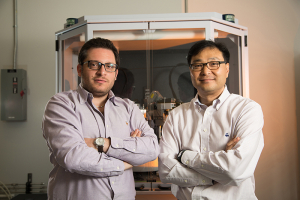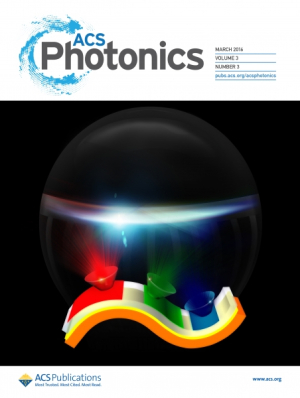The March 2016 cover of ACS Photonics features a theoretical study authored by Cullen College engineers Jae-Hyun Ryou, assistant professor of mechanical engineering, and Shahab Shervin, a materials science and engineering doctoral student.
The study, titled “Bendable III-N Visible Light-Emitting Diodes Beyond Mechanical Flexibility,” explored the potential for low cost, flexible and color changing light-emitting diodes, or LEDs. Ryou and Shervin’s co-authors included Cullen College doctoral student Mojtaba Asadirad, Seung-Hwan Kim from the Metamaterial Electronic Device Research Center at Hongik University, S. Yu. Karpov of STR Group, and Daria Zimina of STR US, Inc.
LEDs are energy efficient light sources with a wide array of potential applications. LEDs convert electrical current to light approximately 10 times more efficiently than incandescent lamps and approximately two to three times more efficiently than fluorescent lamps. By converting electrical current more efficiently, they offer the potential to reduce green house gas emissions from electricity use.
In recent years, LEDs have become more prevalent in households, automobiles and even large-scale stadium displays. Yet, they are still less commonly used than incandescent and fluorescent light sources.
One of the major barriers to market penetration and widespread household use is the relatively high cost of LED bulbs compared to cheaper traditional light bulbs, said Ryou. LEDs cost more to purchase because they are more expensive to mass-produce. The substrate currently used for LED production is not only higher-priced than its traditional counterparts, but it can only be used in relatively small quantities, further driving up the costs of large-scale manufacturing.
“We need a cheaper option,” said Ryou.
Shervin, who served as first author on the study, researches the potential for flexible LEDs on inorganic material to reduce mass-production costs and increase reliability and efficiency. He said that the theoretical ability to create color-changing LEDs was an unexpected and surprising bonus.
“Through our calculations, we’ve shown that bending or applying strain to an LED structure can improve its efficiency,” he said. “We also demonstrated that bending an LED structure can cause it to emit different colors of light [without changing the composition.]”
Current LED technology uses phosphorous, which is a non-environmentally friendly material, to produce white light emission. Ryou and Shervin achieved white light emission without the use of phosphorous by combining green, red and blue light emissions from a single flexible LED. The researchers said they hope their study promotes the use of eco-friendly alternative materials.
Shervin said he envisions future roll-to-roll LED fabrication using amorphous or polymorphous substrates, enabling cost-efficient mass production.
“We are taking a totally new approach [to LED manufacturing]” said Ryou. With this research, he and Shervin hope to provide the foundation for future LED technology and contribute to its increased everyday use.
“[Being featured on the journal cover] is motivating. We have a lot of work ahead, but it’s exciting to have our efforts recognized with this work on the cover,” Shervin said.
“I’ve always been interested in energy-related research and the University of Houston offers a huge sea of research opportunities,” he added.
ACS Photonics is a monthly journal dedicated to research articles, letters, perspectives, and reviews, encompassing the full scope of published research in the photonics field.
View the article in ACS Photonics online.

